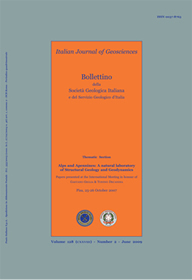
Rivisitazione geologica della grande Galleria dell'Appennino
Massimo Coli(*) & Alice Pinzani(*)
(*) Dipartimento di Scienze della Terra, UNIFI, via G. La Pira, 4 -
50121 Firenze, Italia. E-mail: coli@unifi.it.
Volume: 128 (2009) f.3
Pages: 747-757
Abstract
The railway connections between the Po area and the central Tyrrhenian part of Italy had already been in place since the XIX century with the Pontremolese, Porrettana and Faentina railway lines; but these lines did not offer, either singularly, or together, a capable, rapid and economic means of transit needed for the amount of traffic that went along the axis of the Peninsula (DE MARTINO, 1934). In order to overcame these limitation the Eng. Protche project was considered the best, the Apennines would have been crossed by means of a great 18.023 m tunnel, with a pass at a height of 328 m above sea level, and would have slopes reaching of no more than 12‰.
During the time of construction of the Great Tunnel the geological setting of the Apennines followed the classic Tuscan geological school of thought (MADDALENA, 1929, 1933; SACCO, 1934) (fig. 5) which ordered the different layers from highest to lowest:
1a) alternated layers of sandstones with slates;
1b) marly Limestone with interposed slates;
2a) Slates and Argille Scagliose (with interposed ophiolitic rocks);
2b) arenaceous schists, sandstone and marls with alternations of argillaceous schists and marly limestone;
3) Sandstones (hard sandstone) in thick beds, regularly alternating with argillaceous-arenaceous schists.
GEOLOGICAL KNOWLEDGE TODAY Geological studies of last the 40 years have come to subdivide the «Argille Scagliose» (SALMOJRAGHIi, 1881; MERLA, 1951) that constitutes a good part of the Padana-Bolognese Apennines in several units which are part of the external Ligurian Units (ABBATE et alii, 1969) and the «Chaotic Complex» (TAWNY, 1973; ABBATE & SAGRI, 1982). Recent geological study and survey (BETTELLI & PANINI, 1987; BETTELLI et alii, 2002; Panini et alii, 2002; Sheet 252 Barberino del Mugello and Sheet 237 Sasso Marconi, scale 1:50.000) have brought about distinctions also within the «Chaotic Complex» itself. The geological setting along the tunnel is summarised in tab. 1.
GEOLOGICAL SECTION IN THE AXIS OF TUNNEL Based on the excavation reports of the Great Tunnel of the Apennines, including the lithological description of the rock masses crossed and the present knowledge of the geological order, a geological section was designed (tav. 1; original in a scale of 1:10.000) that aids in reinterpreting the geo-structural order of the rock masses crossed by the tunnel.
Swelling Digging that occurred in predominantly argillaceous formations and that was strongly tectonic was hindered because of a strong pressure coming from the terrain and pushing against the support system and the wall coverings; the stretch of the tunnel that had the most problems when digging because of the phenomenon of swelling was the 600 m, between PK 2.380 and 3.000 from the north in the «Argille Scagliose» (AVC).
Grisou During the digging of the Great Tunnel of the Apennines very light to abundant gas emissions manifested themselves in rock masses where the argillaceous element predominated and above all in the «Argille Scagliose» (now AVC and APA). Based on the information found in several articles and reports, there were two types of gas emissions: high and low pressure. The high pressure emissions, were in general unexpected, with remarkable capacities and were connected to calcareous and arenaceous elements that were fractured and deformed as found in stone within the argillaceous formations, Argilloso-Calcarea Unit (AVC). The low pressure emissions were of a modest capacity and occurred in rock masses that were mostly argillaceous.
Most of the gas emissions registered took place in areas associated with faults, fractures and thrusts, that is, components that are prevalently vertical allowing a means of escape for gas coming from the deep underground.
Water In the Great Tunnel of the Apennines, water infiltration was more frequent at the southern entrance of the tunnel characterized by the presence of sandstone. The only exception was in the first 780 m from the southern entrance where «Scisti Galestrini» alternately crossed with sandstones (Formation delle Marne Varicolori di Villore, MVV).
The water flow found in the tunnel was influenced by a direction-orientation of discontinuities, with the water flow concentrated along the overhead plains and in areas that were intensely fractured and detensionate. The water capacity in the tunnel gallery diminished with the passing of time and after the completion of the covering of the walls there remained no trace. As a whole, the water infiltrations evoked difficult interventions such as pumping out water. It also involved security issues, delays in the works and increased costs and a large impact on the water resources of the area, that only after many years has found an equilibrium.
CONCLUSIONS The geological re-visitation of the Great Tunnel of the Apen-nines has allowed us to review its geological order at the axis of the tunnel, as well as reinterpret the excavation data in light of the geological knowledge that we have today about the area. In addition, it allowed us to delineate a geological order of the underground based on a sort of horizontal survey, which helped to calibrate and verify geological orders and hypotheses deriving from the new surface geological data. Knowing the history of the critical geological situation aided in comparing that which was encountered during the recent TAV and VAV works, which was found to be identical. This present work, besides contributing to the history and demonstrating the significance of a complex work such as the Great Gallery of the Apen-nines, also shows how a critical and contemporary re-reading of past experiences can greatly contribute in the phase of planning more complex works in the same geological context.
Keywords
Get Full Text